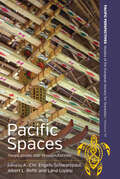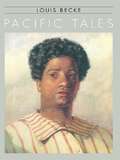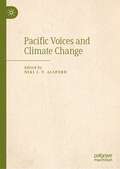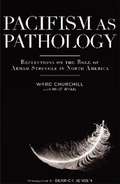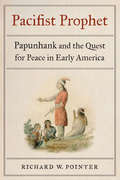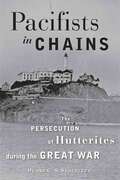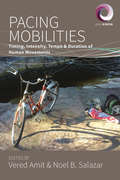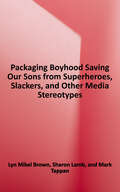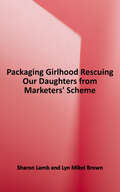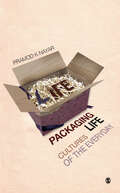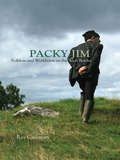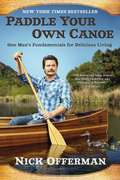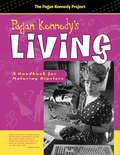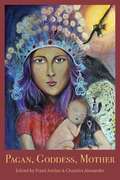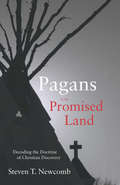- Table View
- List View
Pacific Spaces: Translations and Transmutations (Pacific Perspectives: Studies of the European Society for Oceanists #10)
by Albert L. Refiti A.-Chr. Engels-Schwarzpaul, Lana LopesiDelving into Pacific spaces from a variety of disciplinary perspectives and interpretations, this book looks at how the anthropological and architectural can be connected. The contributors to this book – architectural practitioners, architectural and spatial design theorists, anthropologists and historians – show not only how new theoretical perspectives can arise out of comparing aspects specific to one discipline with their equivalents of another, but also demonstrate how a space of emergence is created for something that goes beyond both, enhancing both fields of potentialities.
Pacific Tales (Short Story Index Reprint Ser.)
by BeckeGeorge Lewis Becke (1848-1913) was an Australian short-story writer and novelist. He began his voyages in the south seas at a very early age and there are two accounts of these beginnings: one by the Earl of Pembroke, who presumably obtained his information from Becke, which is prefixed to By Reef and Palm (1894), and the other written by Becke. It is difficult to reconcile them, and all that is certain is that Becke spent many years on vessels trading in the Pacific islands. Becke went to London, and he remained in Europe for about 15 years, during which time a large number of collections of short stories and a few novels and stories for boys were published. He was fairly paid by the magazines for his stories, but he always sold his books outright. About 30 of Becke's books are listed in Miller's Australian Literature with six other volumes written in collaboration with W. J. Jeffery. Among Becke's books are: The Naval Pioneers of Australia (1899), and By Rock and Pool on an Austral Shore and Other Stories (1901).
Pacific Voices and Climate Change
by Niki J. P. AlsfordThis book provides a comprehensive overview of issues related to climate change in the Pacific and will be an invaluable reference for those working in this important field. Climate change represents humanity’s greatest threat. The vastness of the Pacific means that no two experiences are the same. This edited volume identifies research that highlights the local impact of climate change on the islands and coastlines of the Pacific. The authors use current research to document climate change via contextually informed studies that engages with local cultures, histories, knowledges, and communities. The transdisciplinary nature and the combination of both academic and non-academic writing makes this book an accessible and important contribution to the field.
Pacification: Burma
by Sir C. CrosthwaiteOriginally designed as a field guide for soldiers and civilians serving in Burma in the heyday of the British Empire, this book will be invaluable to historians seeking to understand the imperial mindset and the annexation of Burma.
Pacifism and Pentecostals in South Africa: A new hermeneutic for nonviolence (Routledge New Critical Thinking in Religion, Theology and Biblical Studies)
by Marius NelMost of the early twentieth-century Pentecostal denominations were peace churches that encouraged a stance of conscientious objection. However, since the Second World War Pentecostals have largely abandoned their pacifist viewpoint as they have taken on a more literal Biblical hermeneutic from their interaction with Evangelical denominations. This book traces the history of nonviolence in Pentecostalism and suggests that a new hermeneutic of the Bible is needed by today’s Pentecostals in order for them to rediscover their pacifist roots and effect positive social change. The book focuses on how Pentecostalism has manifested in South Africa during the twentieth century. Much of the available academic literature on hermeneutics and exegesis in the field of Pentecostal Studies is of an American or British-European origin. This book redresses this imbalance by exploring how the Bible has been used amongst African Pentecostals to teach on the apparent paradox of a simultaneously wrathful and loving God. It then goes onto suggest that how the Bible is read directly affects how Pentecostals view their role as potential reformers of society. So, it must be engaged seriously and thoughtfully. By bringing Pentecostalism’s function in South African society to the fore, this book adds a fresh perspective on the issue of pacifism in world Christianity. As such it will be of great use to scholars of Pentecostal Studies, Theology, and Religion and Violence as well as those working in African Studies.
Pacifism as Pathology: Reflections on the Role of Armed Struggle in North America
by Ward Churchill"This extraordinarily important book cuts to the heart of one of the central reasons movements to bring about social and environmental justice always fail. The fundamental question here is: is violence ever an acceptable tool to help bring about social change? This is probably the most important question of our time, yet so often discussions around it fall into clichés and magical thinking: that somehow if we are merely good and nice enough people, the state will stop using its violence to exploit us all. Would that this were true." --Derrick Jensen, author of Endgame, from the introduction. Pacifism, the ideology of nonviolent political resistance, has been the norm among mainstream North American progressive groups for decades. But to what end? Ward Churchill challenges the pacifist movement's heralded victories--Gandhi in India, 1960s antiwar activists, even Martin Luther King's civil rights movement--suggesting that their success was in spite of, rather than because of, their nonviolent tactics. Pacifism as Pathology was written as a response not only to Churchill's frustration with his own activist experience, but also to a debate raging in the activist and academic communities. He argues that pacifism is in many ways counterrevolutionary; that it defends the status quo, and doesn't lead to social change. In these times of upheaval and global protest, this is a vital and extremely relevant book. Ward Churchill is a prolific writer and lecturer, having authored, co-authored, or edited over twenty books. He is a member of the leadership council of Colorado AIM (American Indian Movement).
Pacifist Prophet: Papunhank and the Quest for Peace in Early America
by Richard W. PointerPacifist Prophet recounts the untold history of peaceable Native Americans in the eighteenth century, as explored through the world of Papunhank (ca. 1705–75), a Munsee and Moravian prophet, preacher, reformer, and diplomat. Papunhank&’s life was dominated by a search for a peaceful homeland in Pennsylvania and the Ohio country amid the upheavals of the era between the Seven Years&’ War and the American Revolution. His efforts paralleled other Indian quests for autonomy but with a crucial twist: he was a pacifist committed to using only nonviolent means. Such an approach countered the messages of other Native prophets and ran against the tide in an early American world increasingly wrecked with violence, racial hatred, and political turmoil. Nevertheless, Papunhank was not alone. He followed and contributed to a longer and wider indigenous peace tradition. Richard W. Pointer shows how Papunhank pushed beyond the pragmatic pacifism of other Indians and developed from indigenous and Christian influences a principled pacifism that became the driving force of his life and leadership. Hundreds of Native people embraced his call to be &“a great Lover of Peace&” in their quests for home. Against formidable odds, Papunhank&’s prophetic message spoke boldly to Euro-American and Native centers of power and kept many Indians alive during a time when their very survival was constantly threatened. Papunhank&’s story sheds critical new light on the responses of some Munsees, Delawares, Mahicans, Nanticokes, and Conoys for whom the &“way of war&” was no way at all.
Pacifists in Chains: The Persecution of Hutterites during the Great War (Young Center Books in Anabaptist and Pietist Studies)
by Duane C. StoltzfusDocuments the disturbing history of four pacifists imprisoned for their refusal to serve during World War I.To Hutterites and members of other pacifist sects, serving the military in any way goes against the biblical commandment "thou shalt not kill" and Jesus’s admonition to turn the other cheek when confronted with violence. Pacifists in Chains tells the story of four young men—Joseph Hofer, Michael Hofer, David Hofer, and Jacob Wipf—who followed these beliefs and refused to perform military service in World War I. The men paid a steep price for their resistance, imprisoned in Alcatraz and Fort Leavenworth, where the two youngest died. The Hutterites buried the men as martyrs, citing mistreatment.Using archival material, letters from the four men and others imprisoned during the war, and interviews with their descendants, Duane C. S. Stoltzfus explores the tension between a country preparing to enter into a world war and a people whose history of martyrdom for their pacifist beliefs goes back to their sixteenth-century Reformation beginnings.
Pacifying the Homeland: Intelligence Fusion and Mass Supervision
by Brendan McQuadeThe United States has poured over a billion dollars into a network of interagency intelligence centers called “fusion centers.” These centers were ostensibly set up to prevent terrorism, but politicians, the press, and policy advocates have criticized them for failing on this account. So why do these security systems persist? Pacifying the Homeland travels inside the secret world of intelligence fusion, looks beyond the apparent failure of fusion centers, and reveals a broader shift away from mass incarceration and toward a more surveillance- and police-intensive system of social regulation. Provided with unprecedented access to domestic intelligence centers, Brendan McQuade uncovers how the institutionalization of intelligence fusion enables decarceration without fully addressing the underlying social problems at the root of mass incarceration. The result is a startling analysis that contributes to the debates on surveillance, mass incarceration, and policing and challenges readers to see surveillance, policing, mass incarceration, and the security state in an entirely new light.
Pacing Mobilities: Timing, Intensity, Tempo and Duration of Human Movements (Worlds in Motion #8)
by Vered Amit Noel B. SalazarTurning the attention to the temporal as well as the more familiar spatial dimensions of mobility, this volume focuses on the momentum for and temporal composition of mobility, the rate at which people enact or deploy their movements as well as the conditions under which these moves are being marshalled, represented and contested. This is an anthropological exploration of temporality as a form of action, a process of actively modulating or responding to how people are moving rather than the more usual focus in mobility studies on where they are heading.
Packaging Boyhood: Saving Our Sons from Superheroes, Slackers, and Other Media Stereotypes
by Sharon Lamb Lyn Mikel Brown Mark TappanPlayer. Jock. Slacker. Competitor. Superhero. Goofball. Boys are besieged by images in the media that encourage slacking over studying; competition over teamwork; power over empowerment; and being cool over being yourself. From cartoons to video games, boys are bombarded with stereotypes about what it means to be a boy, including messages about violence, risk-taking, and perfecting an image of just not caring. Straight from the mouths of over 600 boys surveyed from across the U.S., the authors offer parents a long, hard look at what boys are watch ing, reading, hearing, and doing. They give parents advice on how to talk with their sons about these troubling images and provide them with tools to help their sons resist these mes sages and be their unique selves.
Packaging Girlhood: Rescuing Our Daughters From Marketers' Schemes
by Sharon Lamb Lyn Mikel BrownThe stereotype-laden message, delivered through clothes, music, books, and TV, is essentially a continuous plea for girls to put their energies into beauty products, shopping, fashion, and boys. This constant marketing, cheapening of relationships, absence of good women role models, and stereotyping and sexualization of girls is something that parents need to first understand before they can take action. Lamb and Brown teach parents how to understand these influences, give them guidance on how to talk to their daughters about these negative images, and provide the tools to help girls make positive choices about the way they are in the world. In the tradition of books like Reviving Ophelia, Odd Girl Out, Queen Bees, and Wannabees that examine the world of girls, this book promises to not only spark debate but help parents to help their daughters.
Packaging Law Europe (Routledge Revivals Ser.)
by Bailey Patricia M.First published in 1999, this volume responds to the 1991 enactment by the German government of its Packaging Ordinance, which led to new or revised packaging legislation throughout the European Union. Problems caused by this divergent legislation led to the enactment of the Directive on Packaging and Packaging Waste in late 1994. Unfortunately, the imprecision of the Directive necessary to ensure its enactment has led to further disputes. At the heart of these disputes is the classic struggle between the priorities of environmental protection and economic development. This book analyses the implementation of the Directive by Member States, and in particular, issues such as the imposition of quotas on reusable containers; the use of economic instruments and environmental agreements; and competition issues and state aids. The book enlightens readers to the current debates regarding packaging legislation which continue today, despite the enactment of EU legislation.
Packaging Life: Cultures of the Everyday
by Pramod K NayarPackaging Life: Cultures of the Everyday is a study of the cultural politics of four aspects of everyday life-health, comfort, risk and mobility-as manifest in public culture. The book explores the commodification of these aspects, arguing that our experience and perception of these are mediated by discourses circulating in the mass media. The author explores how notions of ′good′ health, ′cosmopolitan′ identities, and ′luxurious′ lifestyles are constructed, arguing that such constructions, or what this book calls ′packaging′, encourage us to buy particular commodities, adopt certain lifestyles, assimilate specific political beliefs and develop significant anxieties. Discourses, he suggests, morph into consumer practices, where particular kinds of bodies, objects, and practices are established as the norm-safe, stylish and cosmopolitan-so that they appear natural, legitimate and desirable and lead us, consumers, to buy, practice, believe in and adopt them. He also analyzes or tries to ′unpack′ this underlying discourse within images, rhetoric, narratives and representations so that we understand the politics behind them. ′Unpacking′ cultural politics, this book demonstrates, is the disentangling of the insidious regulatory frames of representation so that we generate dissident reading practices for public culture. The book is an essential reading for those who want to understand modern urban cultural rhetorics. Scholars and practitioners working in the fields of media and communication, consumer behaviour studies and cultural studies will find it highly engaging as well as provocative.
Packing Inferno
by Tyler E. BoudreauTyler E. Boudreau is a twelve-year veteran of the Marine Corps infantry. He trained and committed himself physically and intellectually to the military life. Then his intense devotion began to disintegrate, bit by bit, during his final mission in Iraq. After returning home, he discovered a turmoil developing in his mind, estranging him from his loved ones and the bill of goods he eagerly purchased as a marine officer. Packing Inferno is the spectacularly written story of the ordeal of a marine officer in battle and then coming home. It is the struggle with a society resistant to understand the true nature of war. It is the fight with combat stress and an exploration into the process of recovery. It is the search for conscience, family, and ultimately for one's essential self. Here are the reflections of a man built by the Marine Corps, disassembled by war, and left with no guidance to rebuild himself. This is Tyler E. Boudreau's first book. He currently lives in western Massachusetts, where he works with other veterans on many projects related to war.
Packy Jim: Folklore and Worldview on the Irish Border
by Ray CashmanGrowing up on a secluded smuggling route along the border of Northern Ireland and the Republic, Packy Jim McGrath regularly heard the news, songs, and stories of men and women who stopped to pass the time until cover of darkness. In his early years, he says, he was all ears—but now it is his turn to talk. Ray Cashman, who has been interviewing McGrath for more than fifteen years, demonstrates how Packy Jim embellishes daily conversation with stories of ghosts and fairies, heroic outlaws and hateful landlords. Such folklore is a boundless resource that he uses to come to grips with the past and present, this world and the next. His stories reveal an intricate worldview that is both idiosyncratic and shared—a testament to individual intelligence and talent, and a window into Irish vernacular culture.
Paddle Your Own Canoe: One Man's Fundamentals for Delicious Living
by Nick OffermanWhen it comes to growing a robust mustache, masticating red meat, building a chair, or wooing a woman, who better to educate you than the always charming, always manly Nick Offerman, best known as Parks and Recreation's Ron Swanson? Combining his trademark comic voice and very real expertise in carpentry, Paddle Your Own Canoe features tales from Offerman's childhood (born, literally, in the middle of an Illinois cornfield) to his theater days in Chicago to the, frankly, magnificent seduction of his wife, Megan Mullally. Offerman also shares his hard-bitten battle strategies in the arenas of manliness, love, styles, and religion, and invaluable advice on getting the utmost pleasure out of woodworking, assorted meats, outdoor recreations, and other palatable entrees.le readers pink but may also rouse them to put down their smart phones, study a few sycamore leaves, and maybe even hand craft (and paddle) their own canoes.
Pagan Kennedy's Living: A Handbook for Maturing Hipsters
by Pagan KennedyPagan Kennedy first captured the hearts of America with her personal zine Pagan's Head. Drawing from this source, she presents not only the zine-world standards, but also includes some helpful dating tips, such as "Pretend to go to the bathroom and never come back." Cruise through this book only if you want an extremely entertaining read and the opportunity to develop an unhealthy fixation on the fabulous Ms. Kennedy. Originally published in 1997, this new edition features "Where are they now" updates.
Pagan Peoples of the Central Area of Northern Nigeria: Western Africa Part XII (Ethnographic Survey Of Africa Ser.)
by Harold GunnRoutledge is proud to be re-issuing this landmark series in association with the International African Institute. The series, published between 1950 and 1977, brings together a wealth of previously un-co-ordinated material on the ethnic groupings and social conditions of African peoples. Concise, critical and (for its time) accurate, the Ethnographic Survey contains sections as follows: Physical Environment Linguistic Data Demography History & Traditions of Origin Nomenclature Grouping Cultural Features: Religion, Witchcraft, Birth, Initiation, Burial Social & Political Organization: Kinship, Marriage, Inheritance, Slavery, Land Tenure, Warfare & Justice Economy & Trade Domestic Architecture Each of the 50 volumes will be available to buy individually, and these are organized into regional sub-groups: East Central Africa, North-Eastern Africa, Southern Africa, West Central Africa, Western Africa, and Central Africa Belgian Congo. The volumes are supplemented with maps, available to view on routledge.com or available as a pdf from the publishers.
Pagan Tribes of the Nilotic Sudan (Routledge Revivals)
by C. G. Seligman Brenda Z. SeligmanFirst published in 1932, Pagan Tribes of the Nilotic Sudan is a general conspectus of the people, traditions, culture, and ways of thought in southern Sudan. The authors give their view of the remote racial origins of the people with whom their studies are concerned and then of the great sub-racial units whom they class as ‘dolichocephals’ and ‘mesaticephals’ respectively. The former comprise, first, the Nilotes – Shilluk, Nuer and Dinka, who live and move and have their being in an atmosphere of cattle, and who, it is thought, had their cradleland somewhere east of the Great Lakes – and, second, the Nilo-Hamites, such as the true Bari, various Lotuko-speaking tribes, etc. The mesaticephals consist of the Fung-Nuba peoples on the one hand and, on the other, the South-Western group of whom Azande are the best known. Exceptional interest is attached to the research conducted among the Bari. The social organization of this tribe is complex and curious, particularly their beliefs regarding rain-stones, rainmakers and clouds. The language used is a reflection of its era and no offence is meant by the Publishers to any reader by this republication. This book will be of interest to students of history, anthropology, ethnography, and ethnic studies.
Pagan, Goddess, Mother
by Nané Jordan;Chandra AlexandreThis anthology calls Pagan and Goddess mothering into focus by highlighting philosophies and experiences of mothers in these spiritual movements and traditions. Pagan and Goddess spirituality are distinct, yet overlapping and diverse communities, with much to say about deity as mother, and about human mothers in relationship to deity. Authors share creative voices, stories, and scholarship from the forefront of Pagan- and Goddess- centered home, in which divine mothers, Goddesses, diverse female embodiments, and generative life cycles are honoured as sacred. Authors inquire into how their spirituality impacts the perceived value and experiences of mothers themselves, while generating new ways of imagining and enacting motherhood in spiritual and daily life. Pagan, Goddess, Mother opens spaces for dialogue in areas such as how Pagan- and Goddess- centred mothers engage in, and are impacted by, their spiritual leadership through practices of ceremony, ritual, magic, and priestessing. Authors consider mothers' lived connections with their children, family life, and themselves, through nature, the Earth, and mothering as a spiritual practice. Chapters reflect upon the ways that Pagan- and Goddess- identified mothers creatively navigate daily interactions with dominant religions, the public sphere, community leadership, and activism facing the challenges of such while forging new pathways for spirited well being in mothering and family life.
Paganism, Traditionalism, Nationalism: Narratives of Russian Rodnoverie (Studies in Contemporary Russia)
by Kaarina AitamurtoRodnoverie was one of the first new religious movements to emerge following the collapse of the Soviet Union, its development providing an important lens through which to view changes in post-Soviet religious and political life. Rodnovers view social and political issues as inseparably linked to their religiosity but do not reflect the liberal values dominant among Western Pagans. Indeed, among the conservative and nationalist movements often associated with Rodnoverie in Russia, traditional anti-Western and anti-Semitic rhetoric has recently been overshadowed by anti-Islam and anti-migrant tendencies. Providing a fascinating overview of the history, organisations, adherents, beliefs and practices of Rodnoverie this book presents several different narratives; as a revival of the native Russian or Slavic religion, as a nature religion and as an alternative to modern values and lifestyles. Drawing upon primary sources, documents and books this analysis is supplemented with extensive fieldwork carried out among Rodnoverie communities in Russia and will be of interest to scholars of post-Soviet society, new religious movements and contemporary Paganism in general.
Pagans in the Promised Land: Decoding the Doctrine of Christian Discovery
by Steven T. NewcombPagans in the Promised Land provides a unique, well-researched challenge to U.S. federal Indian law and policy. It attacks the presumption that American Indian nations are legitimately subject to the plenary power of the United States. Steve Newcomb puts forth a startling theory that U.S. federal Indian law and policy are premised on Old Testament narratives of the chosen people and the promised land, as exemplified in the 1823 Supreme Court ruling Johnson v. McIntosh, that the first "Christian people" to "discover" lands inhabited by "natives, who were heathens," have an ultimate title to and dominion over these lands and peoples. This imporant addition to legal scholarship asserts there is no separation of church and state in the United States, so long as U.S. federal Indian law and policy are premised on the ancient religious distinctions between "Christians" and "heathens."
